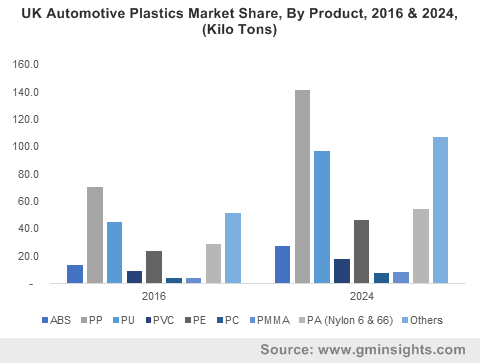PU-based automotive plastics market to garner appreciable momentum by over 2017-2024, global industry revenue to grow two-fold by 2024
Publisher : Fractovia | Published Date : 2018-03-05Request Sample
Primarily pertaining to the rising concerns regarding soaring CO2 levels in the environment, automotive plastics market has depicted a significant emergence in recent times and is anticipated to witness a commendable growth rate over 2017-2024. Regulatory bodies have been giving increased importance to the need of reducing fuel consumption and designing more energy efficient vehicles. For instance, the Corporate Average Fuel Efficiency standards of the United States mandates the lowering of fuel consumption of passenger cars so that it reaches 54.5 miles per gallon by 2025. It has been estimated that to meet the European and U.S. objectives of reducing greenhouse gas emissions, vehicle weight has to be reduced by at least 30% by 2024. For this purpose, a large-scale adoption of lightweight materials will be registered by the automotive industry that will inevitably stimulate automotive plastics market, given that plastics will be heavily deployed for vehicle body weight reduction by 25% to 70%. Besides, plastics and composites are also preferred for the superior aesthetics they add to the vehicles and the ease of usability they offer, thus adding momentum to automotive plastics market.
U.S. Automotive Plastics Market Size, By Product, 2016 & 2024, (USD Million)

How the evolution of exterior and interior design has impacted automotive plastics market trends
Use of plastics in automobiles has revolutionized autobody exterior designs, driving automotive plastics market size. The incorporation of plastics on door panels to bumpers has not only enhanced mileage but also allowed unforeseen creative freedom to engineers and designers to create innovative concepts. The gradual replacement of metals by plastics has thus been stimulating automotive plastics industry share. Metals are not only more expensive than plastics but also more susceptible to dents and corrosion, drawbacks that plastics have nearly wiped out besides offering better energy management, reduced production cost and styling improved aerodynamic exteriors. Due to the low cost single unit production that has been made affordable in automobile manufacturing, automotive plastics market has indeed registered substantial growth in recent years.
Polyurethanes automotive plastics market is estimated to witness a CAGR of 10% over 2017-2024, on account of the increased product application of PU in the interior design of automobiles. The soft touch coatings on interiors such as on steering wheel, instrument panel, gear shift knob, etc., use PU to enhance performance and feel. PU foams are also used in head rests and cushions, and the product is also an excellent insulating material that helps in noise reduction and acts as an effective shock absorber for a more comfortable ride, adding to the growth of automotive plastics market. Elaborating further, PU helps to achieve the lightweight-goals of automakers, which is a major reason for the growth of automotive plastics industry. For instance, PU seat frames are 35% lighter than metal stamped frames. Automotive plastics market is projected to surpass $17 billion by 2024 from the interior and exterior furnishings sector.
Plastics are not only light weight but also have greater weight to strength ratio, enabling enhanced safety in automobiles and stimulating automotive plastics market outlook. Crash tests have proved that though plastics weigh 50% less than metals, they are characterized by higher crush energy absorption. Thus, the automotive plastics industry has benefitted from the use of plastics in the chassis of vehicles so that it uses up a major portion of the impact energy and helps the back portion of the vehicle to remain aligned with the front. Also, with the decrease in weight of all vehicles, there is an added advantage that collisions between light weight vehicles will prove to be less fatal for passengers. It is estimated that the automotive plastics industry will witness a steady gain through the use of plastics in the chassis industry, registering a CAGR of 9% over 2017-2024.
The expansion of the chemical sector has led to automotive plastics industry gaining commendable profits, as chemical companies have been conducting continuous research and development programs to not only come up with more lightweight materials but also cost-effective ones that may lead to vehicle body weight reduction by 25% to 70%. For instance, BASF has led the lightweight revolution by developing solutions to produce lighter structural components that are made of fiber impregnated with resins and then molded with plastics. This new kind of material has been readily adopted by the automotive industry which has started to use the material for mass production. It is expected that by 2020 plastics will replace metals in the entire structure of vehicles and new concepts and designs for vehicles will take root sooner than anticipated. In spite of some of the roadblocks faced by automotive plastics industry such as constricted supply of raw material and steep expenses, the business sphere is expected to depict quite a healthy growth rate. As per estimates, automotive plastics market size will cross a valuation of $50 billion by 2024 – much more than twice the revenue generation that this industry registered in 2016.